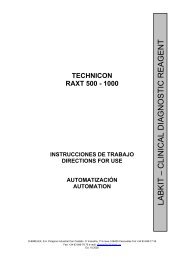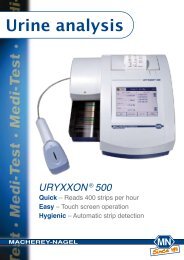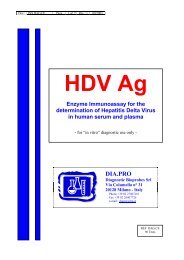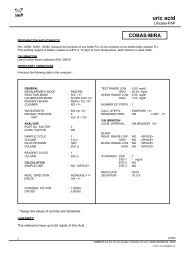OnSite Dengue IgG/IgM Combo Rapid Test ... - Grupo Moscaro
OnSite Dengue IgG/IgM Combo Rapid Test ... - Grupo Moscaro
OnSite Dengue IgG/IgM Combo Rapid Test ... - Grupo Moscaro
You also want an ePaper? Increase the reach of your titles
YUMPU automatically turns print PDFs into web optimized ePapers that Google loves.
<strong>OnSite</strong> <strong>Dengue</strong> <strong>IgG</strong>/<strong>IgM</strong> <strong>Combo</strong> <strong>Rapid</strong> <strong>Test</strong>-(Serum / Plasma / Whole Blood) Page 1 of 2Catalog Number R0061CIn vitro DiagnosticINTENDED USEThe <strong>OnSite</strong> <strong>Dengue</strong> <strong>IgG</strong>/<strong>IgM</strong> <strong>Combo</strong> <strong>Rapid</strong> is a lateral flow immunoassay for the simultaneousdetection and differentiation of <strong>IgG</strong> and <strong>IgM</strong> anti–dengue virus (DEN 1, DEN2, DEN3, andDEN4) in human serum, plasma or whole blood. It is intended to be used as a screening testand as an aid in the diagnosis of infection with dengue viruses. Any reactive specimen withthe <strong>OnSite</strong> <strong>Dengue</strong> <strong>IgG</strong>/<strong>IgM</strong> <strong>Combo</strong> <strong>Rapid</strong> <strong>Test</strong> must be confirmed with alternativetesting method(s).SUMMARY AND EXPLANATION OF THE TEST<strong>Dengue</strong> viruses, a family of four distinct serotypes of viruses (Den 1,2,3,4), are single-strained,enveloped, positive-sense RNA viruses. The viruses are transmitted by mosquitoes of thedaytime-biting Stegemyia family, principally Aedes aegypti, and Aedes albopictus. Today,more than 2.5 billion people living in the areas of tropical Asia, Africa, Australia, and theAmericas are at risk for dengue infection. An estimated 100 million cases of dengue fever and250,000 cases of life-threatening dengue hemorrhagic fever occur annually on a worldwidebasis 1-3 .Serological detection is a common method for the diagnosis of infection with dengue viruses.<strong>IgM</strong> anti-dengue virus starts to appear at 3 days after initial exposure and remain in thecirculation for about 30-60 days. <strong>IgG</strong> anti-dengue virus raise at around 7 days, peak at 2-3weeks, and persist for life 4-6 .The <strong>OnSite</strong> <strong>Dengue</strong> <strong>IgG</strong>/<strong>IgM</strong> <strong>Combo</strong> <strong>Rapid</strong> <strong>Test</strong> detects <strong>IgG</strong> and <strong>IgM</strong> anti-dengue virus testwithin 15 minutes. The test is user-friendly, without the need for cumbersome laboratoryequipment.TEST PRINCIPLEThe <strong>OnSite</strong> <strong>Dengue</strong> <strong>IgG</strong>/<strong>IgM</strong> <strong>Rapid</strong> <strong>Test</strong> isa lateral flow chromatographic immunoassay.The test cassette consists of: 1) a burgundycolored conjugate pad containing denguerecombinant envelope antigens conjugatedwith colloid gold (dengue conjugates) andrabbit <strong>IgG</strong>-gold conjugates,2) a nitrocellulosemembrane strip containing two test bands(T1 and T2 bands) and a control band (C band).The T1 band is pre-coated with the antibodyfor the detection of <strong>IgG</strong> anti-dengue virus, T2band is coated with antibody for the detectionof <strong>IgM</strong> anti-dengue virus, and the C band ispre-coated with goat anti rabbit <strong>IgG</strong>.<strong>IgM</strong> <strong>IgG</strong>When an adequate volume of test specimen is dispensed into the sample well of the testcassette, the specimen migrates by capillary action across the cassette. <strong>IgG</strong> anti-dengue virusif present in the specimen will bind to the dengue conjugates. The immunocomplex is thencaptured by the reagent coated on the T1 band, forming a burgundy colored T1 band,indicating a dengue virus <strong>IgG</strong> positive test result and suggesting a recent or repeat infection.5. Do not use the components in any other type of test kit as a substitute for thecomponents in this kit.6. Do not use hemolized blood specimen for testing.7. Wear protective clothing and disposable gloves while handling the kit reagents andclinical specimens. Wash hands thoroughly after performing the test.8. Users of this test should follow the US CDC Universal Precautions for prevention oftransmission of HIV, HBV and other blood-borne pathogens.9. Do not smoke, drink, or eat in areas where specimens or kit reagents are beinghandled.10. Dispose of all specimens and materials used to perform the test as biohazardouswaste.11. Handle the Negative and Positive Control in the same manner as patient specimens.12. The testing results should be read within 15 minutes after a specimen is applied tothe sample well or sample pad of the device. Reading result after 15 minutes maygive erroneous results.13. Do not perform the test in a room with strong air flow, ie. an electric fan or strong airconditioning.REAGENT PREPARATION AND STORAGE INSTRUCTIONSAll reagents are ready to use as supplied. Store unused test devices unopened at 2°C-30°C.The positive and negative controls should be kept at 2°C-8°C. If stored at 2°C-8°C, ensure thatthe test device is brought to room temperature before opening. The test device is stablethrough the expiration date printed on the sealed pouch. Do not freeze the kit or expose the kitover 30°C.SPECIMEN COLLECTION AND HANDLINGConsider any materials of human origin as infectious and handle them using standardbiosafety procedures.Plasma1. Collect blood specimen into a lavender, blue or green top collection tube (containingEDTA, citrate or heparin, respectively in Vacutainer® ) by veinpuncture.2. Separate the plasma by centrifugation.3. Carefully withdraw the plasma into new pre-labeled tube.Serum1. Collect blood specimen into a red top collection tube (containing no anticoagulants inVacutainer®) by veinpuncture.2. Allow the blood to clot.3. Separate the serum by centrifugation.4. Carefully withdraw the serum into a new pre-labeled tube.<strong>Test</strong> specimens as soon as possible after collecting. Store specimens at 2°C-8°C if not testedimmediately. Specimens can be stored at 2°C-8°C up to 5 days. The specimens should befrozen at -20°C for longer storage.Avoid multiple freeze-thaw cycles. Prior to testing, bring frozen specimens to roomtemperature slowly and mix gently. Specimens containing visible particulate matter should beclarified by centrifugation before testing. Do not use samples demonstrating gross lipemia,gross hemolysis or turbidity in order to avoid interference on result interpretation.BloodDrops of whole blood can be obtained by either finger tip puncture or veinpuncture. Do not useany hemolized blood for testing.Whole blood specimens should be stored in refrigeration (2°C-8°C) if not tested immediately.The specimens must be tested within 24 hours of collection.<strong>IgM</strong> anti-dengue virus, if present in the specimen, will bind to the dengue conjugates. Theimmunocomplex is then captured by the reagent pre-coated on the T2 band, forming aburgundy colored T2 band, indicating a dengue virus <strong>IgM</strong> positive test result and suggesting afresh infection.Absence of any T bands (T1 and T2) suggests a negative result.The test contains an internal control (C band) which should exhibit a burgundy colored band ofthe immunocomplex of goat anti rabbit <strong>IgG</strong>/rabbit <strong>IgG</strong>-gold conjugate regardless of the colordevelopment on any of the T bands. Otherwise, the test result is invalid and the specimenmust be retested with another device.REAGENTS AND MATERIALS PROVIDED1. Each kit contains 30 test devices, each sealed in a foil pouch with three items inside:a. One cassette device.b. One pipette dropper.c. One desiccant.2. Sample Diluent (1 bottle, 5 mL)3. One Package Insert (instruction for use).MATERIALS MAY BE REQUIRED AND AVAILABLE FOR PURCHASE1. Positive Control (1 vial, red cap, 1 mL, Cat # R0061-P)2. Negative Control (1 vial, green cap, 1 mL, Cat # R0061-N)1. Clock or TimerMATERIALS REQUIRED BUT NOT PROVIDEDWARNINGS AND PRECAUTIONSFor in Vitro Diagnostic Use1. This package insert must be read completely before performing the test. Failure tofollow the procedures required in the insert gives inaccurate test results.2. Do not open the sealed pouch, unless ready to conduct the assay.3. Do not use expired devices.4. Bring all reagents to room temperature (15°C-30°C) before use.Step 1:Step 2:Step 3:Step 4:ASSAY PROCEDUREBring the specimen and test components to room temperature if refrigerated orfrozen. Once thawed, mix the specimen well prior to assay.When ready to test, open the pouch at the notch and remove device. Place the testdevice on a clean, flat surface.Be sure to label the device with specimen’s ID number.For whole blood test- Apply 1 drop of whole blood (about 40-50 µL) into the sample well.- Then add 1 drop (about 35-50 µL) of Sample Diluent immediately.or1 drop of whole blood 1 drop of sample diluentFor serum or plasma test- Fill the pipette dropper with the specimen.- Holding the dropper vertically, dispense 1 drop (about 30-45 µL) of specimen intothe sample well making sure that there are no air bubbles.- Then add 1 drop (about 35-50 µL) of Sample Diluent immediately.1 drop of specimen 1 drop of sample diluent 15 minutesResult
<strong>OnSite</strong> <strong>Dengue</strong> <strong>IgG</strong>/<strong>IgM</strong> <strong>Combo</strong> <strong>Rapid</strong> <strong>Test</strong>-(Serum / Plasma / Whole Blood) Page 2 of 2Step 5:Set up timer.PERFORMANCE CHARACTERISTICSStep 6: Results can be read in 15 minutes. Positive results can be visible in as short as 1minute.Don’t read result after 15 minutes. To avoid confusion, discard the test device after interpretingthe result. Recommendation: Take a digital photograph for record keeping.QUALITY CONTROLUsing individual <strong>OnSite</strong> <strong>Dengue</strong> <strong>IgG</strong>/<strong>IgM</strong> <strong>Combo</strong> <strong>Rapid</strong> <strong>Test</strong> cassettes as described in theAssay Procedure above, run 1 Positive Control and 1 Negative Control under the followingcircumstances to monitor test performance:1. A new operator uses the kit, prior to performing testing of specimens.2. A new test kit is used.3. A new shipment of kits is used.4. The temperature used during storage of the kit falls outside of 2°C-30°C.5. The temperature of the test area falls outside of 15°C-30°C.Expected results are as follows:Negative ControlOnly the C band shows color development,the two T bands (T1 and T2) showno color development.Positive ControlThe C band and two T bands (T1 and T2)show color development.The appearance of any burgundy color in the T bands, regardless of intensity, must beconsidered as presence of the band.INTERPRETATION OF ASSAY RESULT1. NEGATIVE RESULT: If only the C band is present, the absence of any burgundy colorin the both T bands (T1 and T2) indicates that no anti- dengue virus antibodies aredetected. The result is negative.2. POSITIVE RESULT:2.1 In addition to the presence of C band, if only T1 band is developed, indicates forthe presence of <strong>IgG</strong> anti- dengue virus; the result is positive.2.2 In addition to the presence of C band, if only T2 band is developed, the testindicates for the presence of <strong>IgM</strong> anti-dengue virus. The result is positive.2.3 In addition to the presence of C band, both T1 and T2 bands are developed,indicates for the presence of <strong>IgG</strong> and <strong>IgM</strong> anti-dengue virus. The result is alsopositive.1. Clinical Performance For <strong>IgM</strong> <strong>Test</strong>A total of 224 patient samples from susceptible subjects were tested by the <strong>OnSite</strong> <strong>Dengue</strong><strong>IgG</strong>/<strong>IgM</strong> <strong>Combo</strong> <strong>Rapid</strong> <strong>Test</strong> and by a commercial EIA. Comparison for all subjects isshowed in the following table:<strong>OnSite</strong> <strong>Dengue</strong> <strong>IgG</strong>/<strong>IgM</strong> <strong>Combo</strong> <strong>Rapid</strong> <strong>Test</strong><strong>IgM</strong> EIA <strong>Test</strong> Positive Negative TotalPositive 22 2 24Negative 5 195 200Total 27 197 224Relative Sensitivity: 91.6% , Relative Specificity: 97.5%, Overall Agreement: 96.9%2. Clinical Performance For <strong>IgG</strong> <strong>Test</strong>A total of 226 patient samples from susceptible subjects were tested by the <strong>OnSite</strong> <strong>Dengue</strong><strong>IgG</strong>/<strong>IgM</strong> <strong>Combo</strong> <strong>Rapid</strong> <strong>Test</strong> and by a commercial EIA. Comparison for all subjects isshowed in the following table:<strong>OnSite</strong> <strong>Dengue</strong> <strong>IgG</strong>/<strong>IgM</strong> <strong>Combo</strong> <strong>Rapid</strong> <strong>Test</strong><strong>IgG</strong> EIA <strong>Test</strong> Positive Negative TotalPositive 25 1 26Negative 7 193 200Total 32 194 226Relative Sensitivity: 96.1% , Relative Specificity: 96.5%, Overall Agreement: 96.4%LIMITATIONS OF TEST1. The Assay Procedure and the <strong>Test</strong> Result Interpretation must be followed closely whentesting the presence of antibodies to dengue virus in serum or plasma from individualsubjects. Failure to follow the procedure may give inaccurate results.2. The <strong>OnSite</strong> <strong>Dengue</strong> <strong>IgG</strong>/<strong>IgM</strong> <strong>Combo</strong> <strong>Rapid</strong> <strong>Test</strong> is limited to the qualitative detection ofantibodies to dengue virus in human serum, plasma or whole blood. The intensity of thetest band does not have linear correlation with the antibody titer in the specimen.3. The <strong>OnSite</strong> <strong>Dengue</strong> <strong>IgG</strong>/<strong>IgM</strong> <strong>Combo</strong> <strong>Rapid</strong> <strong>Test</strong> can not be used to differentiate if theinfection is primary or secondary. No information of dengue serotypes can be providedwith this test.4. Serological cross reactivity with other flaviviruses is common (e.g., Japaneseencephalitis, West Nile, yellow fever, etc.), therefore, it is possible that patients infectedwith these viruses may show some level of the reactivity with this test.5. A negative result for an individual subject indicates absence of detectable dengue virusantibodies. However, a negative test result does not preclude the possibility of exposureto or infection with dengue virus.6. A negative result can occur if the quantity of the dengue virus antibodies present in thespecimen is below the detection limits of the assay, or the antibodies that are detectedare not present during the stage of disease in which a sample is collected. Therefore, afollow up test or alternative tests such antigen test or PCR test method is recommendedif the clinical findings strongly suggest an infection or when there is an outbreak.7. Some specimens containing unusually high titer of heterophile antibodies or rheumatoidfactor may affect expected results.8. The results obtained with this test should only be interpreted in conjunction withother diagnostic procedures and clinical findings.REFERENCES1. Gubler DJ, Clark GG. <strong>Dengue</strong>/dengue hemorrhagic fever. The emergence of a globalhealth problem. Emerg Infect Dis 1995;1(2):55–57.2. Gubler DJ, Trent DW. Emergence of epidemic dengue/dengue hemorrhagic fever as apublic health problem in the Americas. Infect Agents Dis 1994;2:383–3933. Monath TP. <strong>Dengue</strong>: The risk to developed and developing countries. Proc Natl AcadSci U S A 1994;91:2395–2400.4. Price DD, Wilson SR, <strong>Dengue</strong> Fever, e-medicine,http://www.emedicine.com/EMERG/topic124.htm, Jan, 2002.5. Innis BL, and Nisalak A, et al: An enzyme-linked immunosorbent assay to characterizedengue infections where denude and Japanese encephalitis co-circulate. Am. J. Trap.Med. Hygiene. 1989: 40: 418-427.6. Anonymous. <strong>Dengue</strong> hemorrhagic fever: diagnosis, treatment, prevention and control.2nd ed. Geneva: World Health Organization, 1997Samples with positive results should be confirmed with alternative testing method(s) and clinicalfindings before a positive determination is made.3. INVALID: If no C band is developed, the assay is invalid regardless of any burgundy colorin the T bands as indicated below. Repeat the assay with a new device.CTK Biotech, Inc.6748 Nancy Ridge Drive, San Diego, CA 92121,USATel: 858-457-8698, Fax: 858-535-1739,E-mail: info@ctkbiotech.comPI-R0061C –E Rev. C Effective date: 2009-06.12For Export Only, Not For Re-sale In the USACEpartner4UEsdoornlaan 13, 3951DB Maarn. The NetherlandsTel.: +31 (0)6.516.536.26Index of CE SymbolsAttention,For in vitrosee instructions for usediagnostic use onlyREF Catalog # Lot NumberUse by<strong>Test</strong>s per kitStore between 2-30°CManufacturerDo not reuseDate of manufacture



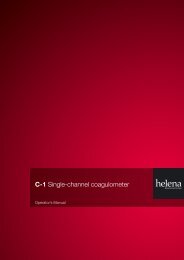
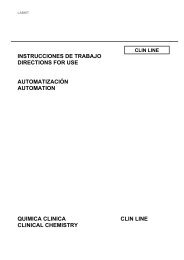
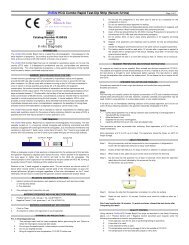
![[APTT-SiL Plus]. - Agentúra Harmony vos](https://img.yumpu.com/50471461/1/184x260/aptt-sil-plus-agentara-harmony-vos.jpg?quality=85)


![[SAS-1 urine analysis]. - Agentúra Harmony vos](https://img.yumpu.com/47529787/1/185x260/sas-1-urine-analysis-agentara-harmony-vos.jpg?quality=85)


![[SAS-MX Acid Hb]. - Agentúra Harmony vos](https://img.yumpu.com/46129828/1/185x260/sas-mx-acid-hb-agentara-harmony-vos.jpg?quality=85)

